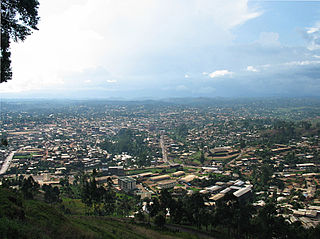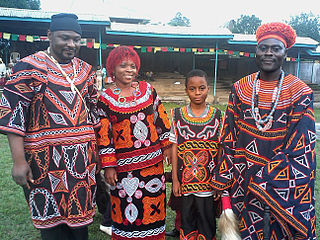
Bamenda, also known as Abakwa and Mankon Town, is a city in northwestern Cameroon and capital of the Northwest Region. The city has a population of about 2 million people and is located 366 km (227 mi) north-west of the Cameroonian capital, Yaoundé. Bamenda is known for its cool climate and scenic hilly location.

The Bamiléké are a group of 90 closely related peoples who inhabit the Western High Plateau of Cameroon. According to Dr John Feyou de Hapy, Bamiléké means people of faith.

The Bamum, sometimes called Bamoum, Bamun, Bamoun, or Mum, are a Grassfields ethnic group located in now Cameroon. In 2018, the Bamum and Bamileke peoples accounted for about 24% of the country's population. The Kingdom of Bamum covers approximately 7,300 km. The Kingdom of Bamum was surrounded to the north by the territory of Cameroon, from the west and south-west the kingdom's boundary touches the River Nun while the Rivers Mape and the Mbam surround it to the east.

Kumbo, also known as Kimbo, is the second-largest city in the North West Province of Cameroon and the capital of Bui Division. It lies about 2000m above sea level and is situated approximately 110 km away from Bamenda, on the Bamenda Highlands Ring Road. Kumbo has a population of 80,212 and is split into three distinctive hilly settlements of Tobin, Mbveh, and Squares. The town is known for horse racing and traditional medicine, and also for its palace, a market and two hospitals. Kumbo is the capital city of the Nso Kingdom of the Nso people. The lingua franca is Lamnso but Pidgin, English, Oku, Djottin, Fulfulde, French and Hausa are spoken.

Bafut is a town located in a modern commune in Cameroon, it is also a traditional fondom. It is located in the Mezam Department, which in turn is located in the Northwest Province.

Mankon is a geo-historic community constituting a large part of Bamenda in Cameroon, formed as an amalgamation of about five different ethnic groups. The Mankon fondom (kingdom) represents one of the oldest monarchies of the grassfield people of the Northwest Province. The fondom is ruled by a fon (king) with rights to kinghood acquired by birth. The crowned fon is usually a designated son of the deceased king, a child who was born only during his reign.
The Bafut Wars were a series of wars fought in the early 20th century between the troops of the Fon of Bafut and German-backed troops of neighbouring fondoms and German troops. The wars ultimately led to a defeat for the Fon of Bafut, forcing him into exile, and making the Fondom of Bafut part of the German protectorate of Kamerun.
The Bafut Subdivision or the Kingdom/Chiefdom/Fondom of Bafut is a commune in the Mezam Department of Northwest Province, Cameroon. It is located in the Western Grassfields region - a name for the Northwest Province and surrounding grassland areas. Bafut is the most powerful of the traditional kingdoms of the Grassfields, now divided into 26 wards along a 10 kilometre stretch of the "Ring Road" that trails along a ridge above the Menchum Valley.

Dance in Cameroon is an integral part of the tradition, religion, and socialising of the country's people. Cameroon has more than 200 traditional dances, each associated with a different event or situation. Colonial authorities and Christian missionaries discouraged native dances as threats to security and pagan holdovers. However, after Cameroon's independence, the government recognised traditional dance as part of the nation's culture and made moves to preserve it.
The Babungo Museum is an art and cultural museum located in Ndop, Cameroon.

The Bandjoun Museum is an art and cultural museum located in Bandjoun, Cameroon.

The Ngemba languages are a group of Eastern Grassfields languages of the Western High Plateau of Cameroon.

Our Lady of Lourdes College, Mankon, is a Roman Catholic, all-girls secondary school located in Mankon, Bamenda in the North-West Region of Cameroon. It is run by the Holy Rosary Sisters under the authority of the Archdiocese of Bamenda. The school is reputed for producing some of the best results in the General Certificate of Education Ordinary and Advanced Levels in Cameroon.
Limbum is a Grassfields language of Cameroon, with a small number of speakers in Nigeria. It is used as a trade language by some, but is primarily the mother tongue of the Wimbum people, who live in Donga-Mantung division of the Northwest Region, at the top of the Ring Road.

Mundum (Bamundum) is a Grassfields Bantu language spoken in Cameroon. It is closely related to Mankon and Mendankwe-Nkwen; along with Mankon, it is called Ngemba. There are two dialects, Anyang and Mberewi.

Mankon is a Grassfields language spoken in Cameroon. It is closely related to Mundum and Mendankwe-Nkwen. Along with Mundum, it is called Ngemba. There are several distinct dialects: Mankunge (Ngemba), Nsongwa, Shomba, Mbutu (Bambutu), Njong (Banjong), Bagangu (Akum) and Alatening.

The Musa Heritage Gallery, is an art museum in Kumbo, Cameroon. It houses a collection of over 400 art objects that were mainly created between 1970 and 2000 and range from bamboo work to wood carvings, from basketry to pottery. The museum is a place for exchanges and education, a place where arts open paths for better understanding of history and traditions from the Grass-fields region of Cameroon.
Adela Elad is a Cameroonian movie actress, producer and philanthropist. She started her acting career in 2012 in the movie University Girls. She won the 2015 edition of African dream achiever award. As a producer, her works include Night in the grassfield under her production Mae Pictures. Her first international movie debut project was Baby Daddy with Nigerian Nollywood producer Emem Isong featuring stars like Alexx Ekubo.

Bafutpeople, also known as Fut or Bufu people are a Grassfields ethnic group located in the Bafut Subdivision of the North West Province, Cameroon.














